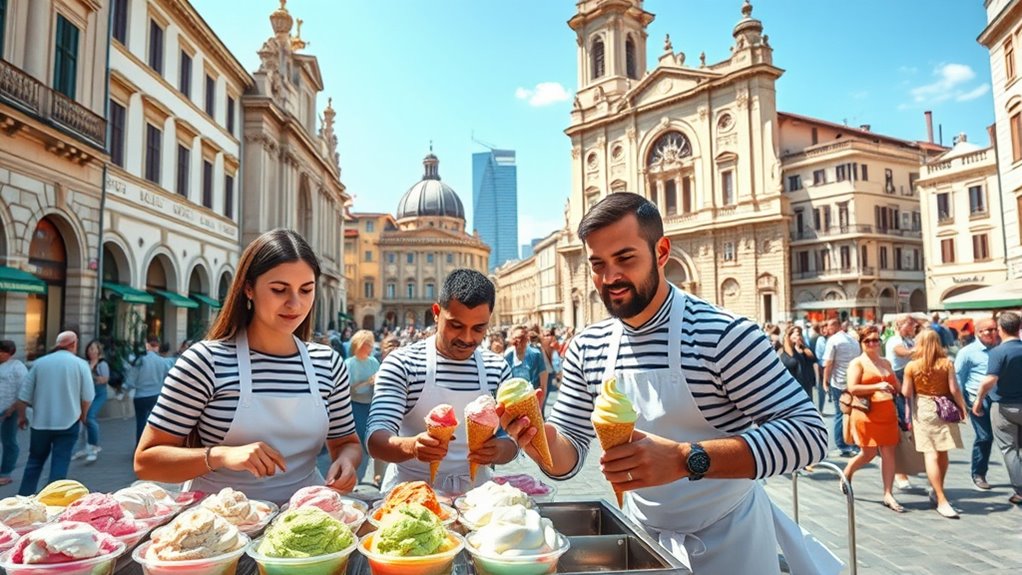Italian immigrants brought their gelato recipes and techniques wherever they went, turning small shops into cultural hubs that shared their love for authentic flavors. They adapted recipes to local ingredients while keeping traditional methods alive, spreading gelato beyond Italy’s borders. These immigrant stories of resilience and passion helped shape a global dessert market. If you keep exploring, you’ll discover how this rich heritage continues to influence gelato’s worldwide popularity today.
Key Takeaways
- Italian immigrants established gelato shops worldwide, serving as cultural hubs that introduced authentic flavors to new communities.
- They transferred traditional recipes across borders, adapting ingredients while preserving core techniques.
- Immigrant artisans refined gelato flavors and methods based on local tastes, creating regional variations.
- Sharing gelato became a way to share stories, heritage, and cultural pride across generations and nations.
- The global spread of gelato reflects immigrant perseverance, innovation, and the enduring legacy of Italian culinary tradition.

Italian immigrants have played a significant role in shaping gelato culture around the world. When they traveled beyond Italy’s borders, they brought with them a rich tradition of making and enjoying gelato, transforming it from a regional specialty into a global delight. As you explore the spread of gelato, you’ll notice how immigrant stories are woven into the fabric of this frozen treat’s history. These stories reveal how families carried their gelato recipes across continents, often adapting them to local ingredients and tastes. This blending of traditions helped create the diverse flavors and styles of gelato enjoyed today.
When immigrant communities settled in new countries, they established small gelato shops and cafes, becoming cultural hubs for their neighborhoods. You might find that many of the classic flavors you love—like pistachio, stracciatella, or lemon—have roots in Italian recipes that immigrants cherished and shared. They didn’t just serve gelato; they shared stories of their homeland, passing down cherished gelato recipes that had been handed through generations. These recipes often carried the essence of Italian summers and family gatherings, making each scoop more than just a treat—it was a connection to their roots.
As you taste gelato in different parts of the world, you’re experiencing more than just a dessert; you’re tasting a piece of immigrant history. Many gelato artisans learned their craft from family members or fellow immigrants, often refining recipes based on local ingredients and preferences. This exchange helped create unique regional variations, which still honor traditional methods. You’ll notice how some shops emphasize creamy textures, while others focus on bold, innovative flavors. All these differences trace back to the immigrant stories and their desire to share a piece of Italy with the world.
Moreover, the influence of immigrant stories extends beyond recipes. It’s about community, resilience, and cultural pride. These stories motivate gelato makers to preserve authentic techniques, such as slow churning and ingredient selection, ensuring the quality remains true to the Italian heritage. Additionally, the introduction of hydrocolloid technology in gelato making has allowed artisans to experiment with new textures and flavors while maintaining that traditional creamy consistency. When you savor a scoop, you’re not just enjoying a sweet treat—you’re partaking in a centuries-old tradition that traveled across borders, nurtured by the dedication of immigrants who wanted to bring a taste of Italy to new lands.
In essence, the spread of gelato culture is a testament to how immigrant stories and recipes have shaped not just a dessert but a global phenomenon. It’s a delicious legacy of perseverance, passion, and cultural exchange that continues to delight people worldwide today.
Frequently Asked Questions
When Did Gelato First Originate in Italy?
You might find it fascinating that gelato origins trace back to Italy in the 16th century, making it a beloved Italian dessert. Its development is linked to the Renaissance period when chefs experimented with richer flavors and smoother textures. As you explore Italian culinary history, you’ll see how gelato became a staple, blending traditional techniques with regional ingredients, and eventually spreading worldwide through Italian immigrants sharing their delicious culture.
Which Countries Have the Largest Italian Immigrant Communities?
You’ll find the largest Italian immigrant communities in countries like the United States, Argentina, Brazil, Canada, and Australia. These communities form part of the Italian diaspora, which has markedly influenced local cultures. As a result, you see culinary fusion, especially with gelato, where Italian traditions blend with local flavors. This spread of gelato culture showcases how Italian immigrants share their culinary heritage, enriching global dessert scenes.
How Did Italian Immigrants Adapt Gelato Recipes Abroad?
You notice that Italian immigrants adapt gelato recipes abroad by customizing gelato flavor adaptations to local tastes. They often incorporate regional ingredients, creating unique artisan recipe variations that appeal to new markets. This flexibility helps maintain authentic gelato traditions while embracing local flavors, making the gelato experience both familiar and exciting for diverse communities. Their adaptability ensures gelato’s popularity continues growing worldwide, blending Italian craftsmanship with local influences.
Are Traditional Gelato-Making Techniques Preserved Internationally?
You’ll find that traditional gelato-making techniques are often preserved internationally, especially in artisanal shops that prioritize ingredient authenticity. These artisans stick to classic methods like slow churning and using fresh, local ingredients to maintain quality. While some adaptations occur, many gelato makers stay true to the artisanal techniques passed down from Italy, ensuring that the authentic texture and flavor of gelato remain intact across the globe.
What Role Did Italian Festivals Play in Spreading Gelato Culture?
You see, Italian festivals played a crucial role in spreading gelato culture by showcasing it during cultural celebrations. These events foster community bonding and allow people to experience authentic flavors firsthand. As you participate in these festivals, you help preserve traditional techniques and share gelato’s rich history. The lively atmosphere and shared passion for Italian heritage make these festivals essential in keeping gelato popular worldwide.
Conclusion
As you savor the sweet, swirling flavors of gelato, imagine the gentle journey of Italian immigrants, softly spreading their passion like a delicate breeze across the world. Their dedication plants tiny seeds of tradition in every corner, blossoming into vibrant cultural tapestries. Each scoop becomes a whispered story of heritage, inviting you to taste a piece of Italy’s heart. Through their quiet efforts, a beloved treat now warmly welcomes you wherever you go, uniting us all in shared delight.









